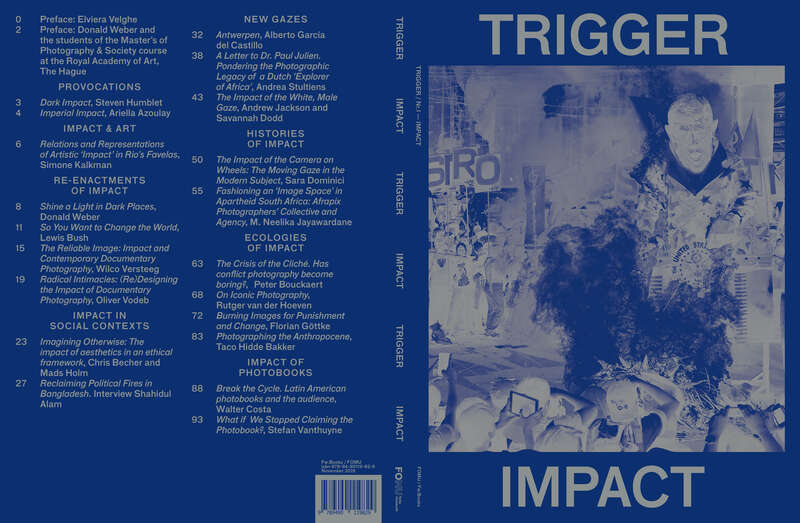
Editorial
Impact & Photography
Impact. What a word. Fraught with multiple meanings and associations, a word for which everybody can create their own definition. Sure, it has some official ones: a bump, bang, or collision of one object into another or a marked effect of influence. I like these definitions, but how do they relate to photography? ‘Impact’, then, is a promiscuous word; it rejects definition. In the months that the Royal Academy of Art, The Hague, and the Photography Museum of Antwerp have been working on this collaborative issue, I decided to jot down a list of everything I saw that used the word ‘impact’, for better or worse (mostly worse). Below, you’ll find a selection of what I found.
Donald Weber and the students of the Master’s of Photography & Society course at the Royal Academy of Art, The Hague
19 nov. 2019 • 5 min
- A creative agency named Impact.
- A real estate agency named Impact.
- A fitness gym named Impact.
- An NGO called ImpactNow.
- I saw three separate universities (Leiden, Tilburg, and Radboud, though surely there’s more) in The Netherlands advertise the ‘impact’ of their research outcomes. The nongovernmental Dutch Research Council has a special online toolkit to help measure your impact.
- There’s the Impact Hub. I saw two of them: one in The Hague, the other in Rotterdam; both are for start-ups and entrepreneurs.
- When I went home to Manchester, New Hampshire, for the summer, I saw another fitness centre named Impact, plus one more creative agency, although this time impact had a lower case i: impact agency.
- There’s an impact wrench, used for loosening lug nuts, and a whole professional wrestling league called IMPACT!
- My friend also told me that impact is used in physics as a form of measurement in some capacity; I didn’t understand.
Anyway, none of this really helped. After looking at my list, I realized that while we may comprehend the question of what impact is, its true nature can be found in the question of why it is. And this is what you’ll see in this publication, that ‘impact’ can be cast as a re-enactment or assertion of radical intimacy, that it initiates a different gaze on the world and that it can exist within an ecology or geography of photography, too. Impact is social, participative, conflictual.
What I like about photography is that it needs a witness. It demands to be looked at, interpreted. Photographs undergo perpetual transformations; they’re constantly remade every time they’re engaged with. They’re context-dependent and contingent, relational and fleeting. Perhaps this is also where the sub-atomic level of impact lies: it sits within everyone’s individual responsibility when they choose to engage, to create their own biography within the unexpected and unpredictable.
So I decided to make a different list, a better list that reflects the ideals of this publication. This one was compiled by master’s students. Each one of them has their own interpretation of impact, and each one of them is right. Or wrong. It doesn’t matter.
- Impact sets the course for change.
- Impact is a set of concepts, visual practices and behaviours that provoke action that in turn provokes change.
- Impact in photography needs to refrain from any comparison to tools of political intervention and direct action; openness in language is what separates art and poetry from propaganda and populism.
- Impact reveals itself in the immeasurable and elusive; it lags behind the immediate and creates demonstrable links between action and reaction.
- Impact is an English word that has many variants in Arabic, and all of them are affiliated with ‘power’. Impact, then, commands us to reflect on the power dynamics of life, to see beyond the paradoxes and contradictions of the surface.
- Impact, according to a pessimist, is a clever new word to deal with the legitimisation of spending taxpayer money on art. The optimist says impact brings people together and works for change in the world. The realist might sit back and contend that good intentions are all one can really offer.
- Impact can exploit; it makes us tools for measurement, nothing more than quantifiable goods.
- Impact should be like Dutch weather: disappointing, unreliable and expectations free.
- Impact lends itself particularly well to a proposal of an alternative view on society.
- Impact is something that is always growing and needs constant nurturing, rather than something that is a final result.
- Impact is a two directional entity—outwardly on the world you move in: politically, emotionally and simply by occupying space. And then the impact that settles inwardly, the impact inflicted onto you.
- Impact. Impacting. Impacted. Impactor. Impactful. Impaction. Impactive. Impart. Impartial. Impasse. Impassion...
- Impact is friction. And friction forces us to pay attention to the forces that move us.
I think I agree with all of these. And you?
With contributions from some of the first- and second-year Master’s of Photography & Society students: Lena Holzer, Thijs van Stigt, Federica Iozzo, Thana Faroq, Xaver Könneker, Mads Jensen, Marta Iwanek, Anders Birger and Gita Cooper-van Ingen.